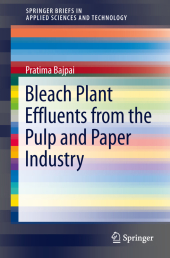 Neuerscheinungen 2013Stand: 2020-01-07 |
Schnellsuche
ISBN/Stichwort/Autor
|
Herderstraße 10
10625 Berlin
Tel.: 030 315 714 16
Fax 030 315 714 14
info@buchspektrum.de |

Pratima Bajpai
Bleach Plant Effluents from the Pulp and Paper Industry
2013. 2013. viii, 88 S. 2 SW-Abb., 16 Tabellen. 235 mm
Verlag/Jahr: SPRINGER, BERLIN 2013
ISBN: 3-319-00544-8 (3319005448)
Neue ISBN: 978-3-319-00544-7 (9783319005447)
Preis und Lieferzeit: Bitte klicken
This book covers bleach plant effluents, that most polluting effluent from the pulp and paper industry. Disappearance of benthic invertebrates, a high incidence of fish diseases, and mutagenic effects on the aquatic fauna are some of the consequences of the disposal of bleach effluents into surface waters. This book describes environmental impact of bleach plant effluents, environmental regulations, and measures to reduce the pollution load by internal process modification and external treatment of bleach plant effluents.
1. Background
1.1 Pollution problems of pulp and paper industry
2. Pulp and Paper making process
2.1 Pulp making Process
2.2 Stock preparation and paper making process
3. Pulp Bleaching and Bleaching effluents
3.1 Pulp Bleaching
3.2 Bleaching effluents
4. Environmental effects of bleach plant effluents
4.1 Environmental Fate and effects
4.2 Environmental issues
4.3 Environmental regulations
5. Stratgies used for reducing the generation of pollutants
5.1 Pollution reduction through Process modification
5.1.1 Nonconventional Pulping Technologies Organosolvent Pulping
Organic acid Pulping
Biopulping
5.1.2 Internal Process Modifications
Extended delignification and Oxygen delignification
Improved pulp washing
Oxidative alkali extraction stage
Substitution of elemental chlorine with chlorine dioxide
Ozone ECF, Totally Chlorine-free Bleaching and Chloride Removal Processes
Bleach filtrate recovery
Enzyme pre-treatment
Fungal pre-treatment
5.2 External treatment
5.2.1 Physico-chemical processes
5.2.2 Electro-chemical processes
5.2.3 Advanced oxidation technologies
5.2.4 Treatment with Enzymes
5.2.5 Treatment with Bacteria
Aerobic treatment
Anaerobic treatment
Sequential aerobic/anaerobic treatment
5.2.6 Treatment with Fungi
6. Conclusions and future perspectives
7. References


